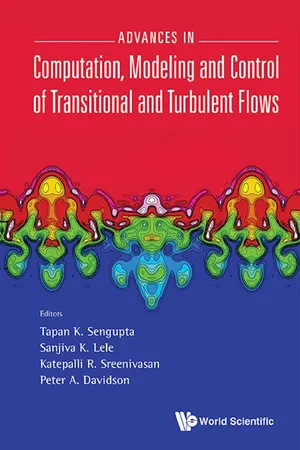
Advances In Computation, Modeling And Control Of Transitional And Turbulent Flows
- 560 pages
- English
- ePUB (mobile friendly)
- Available on iOS & Android
Advances In Computation, Modeling And Control Of Transitional And Turbulent Flows
About This Book
The role of high performance computing in current research on transitional and turbulent flows is undoubtedly very important. This review volume provides a good platform for leading experts and researchers in various fields of fluid mechanics dealing with transitional and turbulent flows to synergistically exchange ideas and present the state of the art in the fields.
Contributed by eminent researchers, the book chapters feature keynote lectures, panel discussions and the best invited contributed papers.
The role of high performance computing in current research on transitional and turbulent flows is undoubtedly very important. This review volume provides a good platform for leading experts and researchers in various fields of fluid mechanics dealing with transitional and turbulent flows to synergistically exchange ideas and present the state of the art in the fields.
Contributed by eminent researchers, the book chapters feature keynote lectures, panel discussions and the best invited contributed papers.
Readership: Researchers, professionals, academics, graduate and senior undergraduates in aerospace engineering, mechanical engineering, engineering mechanics, geophysics and fluid mechanics.
Frequently asked questions
Information
A Critical Assessment of Simluations for Transitional
and Turbulent Flows
Tapan K Sengupta
High Performance Computing Laboratory, Dept. of Aerospace Engg.,
Indian Institute of Technology Kanpur,
Kanpur 208 016, India.
E-mail: [email protected], [email protected]
1. Introduction
Table of contents
- Cover
- Halftitle
- Title Page
- Copyright
- Preface
- Contents
- Large-Eddy Simulation of the Navier-Stokes Equations: Deconvolution, Particle Methods, and Super-Resolution
- Convective Transport in the Sun
- Rapidly-Rotating Turbulence and its Role in Planetary Dynamos
- Low-Order Models for Control of Fluids: Balanced Models and the Koopman Operator
- Different Routes of Transition by Spatio-Temporal Wave-Front
- Bypass Transitional Flow Past an Aerofoil With and Without Surface Roughness Elements
- Global Stability and Transition to Intermittent Chaos in the Cubical Lid-Driven Cavity Flow Problem
- Spatio-Temporal Wave Front – Essential Element of Flow Transition for Low Amplitude Excitations
- Simulations Using Transition Models within the Framework of RANS
- DNS of Incompressible Square Duct Flow and Its Receptivity to Free Stream Turbulence
- Evolution of RANS Modelling of High Speed Mixing Layers using LES
- Numerical Investigation of Centrifugal Instability Around a Circular Cylinder Rotated Impulsively
- Direct Numerical Simulations of Riblets in a Fully-Developed Turbulent Channel Flow: Effects of Geometry
- Computational Studies on Flow Separation Controls at Relatively Low Reynolds Number Regime
- Frequency Dependent Capacitance SDBD Plasma Model for Flow Control
- Effects of Uniform Blowing or Suction on the Amplitude Modulation in Spatially Developing Turbulent Boundary Layers
- Turbulent Drag Reduction in Channel Flow Using Weak-Pressure Forcing
- Drifting of Internal Gravity Wave in a Non-Boussinesq Stably Stratified Turbulent Channel Flow
- Numerical Study of Sink Flow Turbulent Boundary Layers
- Coherent Structure in Oil Body Embedded in Compound Vortex
- Quantitative Characterization of Single Orifice Hydraulic Flat Spray Nozzle
- Shell Model for Buoyancy-Driven Turbulent Flows
- Numerical Simulations in Low–Prandtl Number Convection
- Effect of Buoyancy on Turbulent Mixed Convection Flow Through Vertical and Horizontal Channels
- Computation of Boundary Layer Flow over Porous Laminated Flat Plate
- Boundary Condition Development for an Adverse Pressure Gradient Turbulent Boundary Layer at the Verge of Separation
- Some Interesting Features of Flow Past Slotted Circular Cylinder at Re = 3500
- A High-Resolution Compressible DNS Study of Flow Past a Low-Pressure Gas Turbine Blade
- Numerical Simulation of Impulsive Supersonic Flow from an Open End of a Shock Tube: A Comparative Study
- Green’s Function Analysis of Pressure-Strain Correlations in a Supersonic Pipe, Nozzle and Diffuser
- The Structure of Turbulence in Poiseuille and Couette Flow at Computationally High Reynolds Number
- A New Reynolds Stress Damping Function for Hybrid RANS/LES with an Evolved Functional Form
- Direct Numerical and Large Eddy Simulations of Helicity-Induced Stably Stratified Turbulent Flows
- Comparison of RANS and DNS for Transitional Flow Over WTEA-TE1 Airfoil
- Extracting Coherent Structures to Explore the Minimum Jet Noise
- Synchronized Large-Eddy Simulations for Sound Generation Analysis
- DNS of a Turbulent Jet Issuing from an Acoustically Lined Pipe
- Decomposition of Radiating and Non-Radiating Linear Fluctuating Components in Compressible Flows
- Toward Control of Compressible Shear Flows: Investigation of Possible Flow Mechanisms
- Damping Numerical Oscillations in Hybrid Solvers through Detection of Gibbs Phenomenon
- Forward and Inverse 3D Fourier Transforms of a DNS Wavepacket Evolving in a Blasius Boundary Layer
- Reduced Order Modeling by POD of Supercritical Flow Past Circular Cylinder
- Proper Orthogonal Decomposition vs. Fourier Analysis for Extraction of Large-Scale Structures of Thermal Convection
- Energy Spectrum and Flux of Buoyancy-Driven Turbulence
- DNS of a Buoyant Turbulent Cloud under Rapid Rotation
- Numerical Simulation of Shock-Bubble Interaction using High Order Upwind Schemes
- Rayleigh-Taylor Instability of a Miscible Fluid at the Interface: Direct Numerical Simulation
- A High Resolution Differential Filter for Large Eddy Simulation on Unstructured Grids for High-Order Methods
- A Critical Assessment of Simulations for Transitional and Turbulent Flows
- Panel Discussion